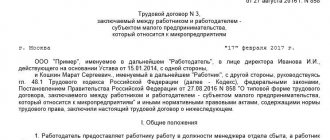In the process of industrial relations, non-standard situations often arise that require work to be performed without complying with the parameters of working conditions and payment, approved by the internal labor documentation of the business entity. Assigning additional responsibilities to an employee is possible only after obtaining the employee’s consent and completing the appropriate documentation.
It does not take into account whether the additional work qualifies as the main job or not.
Adding additional responsibilities to the main job
Legislative regulation
When assigning additional responsibilities to an employee, one should rely on current legislative norms and internal documentation of the enterprise.
The list of responsibilities of each employee is determined by the terms of the employment contract, the elements of which must be reflected in the job description. When preparing documentation, you should take into account the range of responsibilities regulated by a particular profession and the qualification requirements for it.
If there is a production need to perform work that is not taken into account by the internal regulatory documentation drawn up for a specific employee position, it is necessary to make appropriate changes to it. To do this, it is necessary to adjust the documentation regulating labor relations.
Legal norms
The Labor Code defines the rights of each employee of a business entity to work in accordance with the requirements of a formalized agreement with the employer.
He is not authorized to assign additional duties to hired workers without obtaining their consent. To legally make changes to the documentation regulating changes in labor parameters, it is necessary to notify the employee in writing about the planned changes no later than 2 months before their implementation. Adjustments to duties can only be made after receiving the employee’s written consent after two months from the date of the event.
It is worth noting that if, when the list of works is changed, the employee’s functional responsibilities do not change, then the internal documentation of the enterprise can be changed without the consent of the employees. After the internal documentation has been completed and put into effect, employees must be familiarized with the list of obligations set out in the new edition.
Documents regulating responsibilities
Logic dictates that these are the ones that will need to be amended when additional responsibilities are assigned.
- Employment contract.
As Part 2 of Article 57 of the Labor Code states, it must indicate the work function of the person being hired - work in one or more specialties within the qualifications. Naturally, a range of specific responsibilities is outlined. If this “circle” somehow changes, the employment contract will have to be adjusted. FOR YOUR INFORMATION! No one can oblige an employee to perform work that is not specified in the employment contract. All actions to change the main document are carried out exclusively with the prior consent of the employee 2 months before the planned changes in response to a written notification to management. - Job description.
The employer can choose the duties it requires from the employee. If the legal conditions set out in the employment contract, and most importantly, the work function, do not change, then the manager has the right to change the job description without taking into account the opinions of employees. IMPORTANT! Managers try to secure the goodwill of subordinates when changing their responsibilities, otherwise cooperation is unlikely to be effective and last long.
There are 2 options for creating a list of responsibilities:
- as an annex to the employment contract - then in case of any changes it will be necessary to conclude an additional agreement to the main document;
- as a local regulatory legal act - you can issue a modified version of the job description and ask the employee to endorse it: this will be evidence of his acceptance of new responsibilities.
When additional responsibilities are necessary
Non-standard production situations that require additional obligations to be imposed on employees may be due to the absence of an employee from the workplace, whose responsibilities are transferred to the shoulders of other persons. The reasons for the event may be illness, vacation or medical examination. If the solution to a production problem is within the competence of a specialist who has a specific qualification, a specialty for which is not included in the staffing table, then such obligations can be assigned to an employee who has the appropriate education and skills.
Dependence of labor parameters and remuneration on the applied method of assigning additional responsibilities
An increase in the volume of product output, as well as changes in production regulations, may require additional work not previously provided for by the business entity. New responsibilities may be assigned to an employee within the limits of his competence.
It is important to correctly formalize additional responsibilities for the employee in order to eliminate later disputes regarding remuneration and incompetent performance of duties, which the employee may not be aware of.
How to assign additional responsibilities to an employee
In order to assign additional responsibilities to an employee, it is necessary to act in accordance with an algorithm, the implementation of which will help legally competently solve the production problems that have arisen:
- Drawing up notification of planned changes in working conditions and remuneration. The document must indicate the reason for the actions planned by the employer and the identifying information of the employee in respect of whom all measures will be taken. It is important to indicate the period for which changes are planned.
- Providing the document to the employee for review and signature, which will indicate his consent to work under the new rules.
- Amendments to internal regulations providing for the procedure for imposing additional responsibilities.
- Drawing up an additional agreement to the employment contract. It is recommended that the document reflect a list of imputed additional obligations and the period for which they will be assigned to the employee, as well as the procedure for remuneration. It can be determined as a payment of a fixed amount or as a percentage of a specific salary.
- Making an order.
Algorithm of actions
How to register temporary performance of duties by another employee
Step 1.
Deciding on the method of temporary performance of duties Attention! An employee may refuse to perform additional work ahead of schedule by notifying the employer in writing no later than three working days in advance (part four of Article 60.2 of the Labor Code of the Russian Federation). It must be borne in mind that if the acting employee is released from his main job, then this is a temporary transfer to another job (part.
first st. 72.2 of the Labor Code of the Russian Federation). Step 2. We obtain the written consent of the employee Step 3. We conclude an additional agreement to the employment contract Attention!
If the manager does not formalize and pay for additional work in any way, he may be held administratively liable in the form of a fine of 1,000 to 5,000 rubles (Article 5.27 of the Code of Administrative Offenses of the Russian Federation) Step 4. We issue an order for the temporary performance of additional duties Step 5.
We set an additional payment Remember the main thing Says: Larisa Gordeeva - head of the HR department of Personnel-Group T LLC (Tomsk): Ivan Uteshev - legal consultant of the Insurance Joint Stock Company (Moscow): Milana Dubrovskaya - head of the HR administration and settlements with personnel practice of Adolex LLC (Moscow):
Additional responsibilities within one position
The main document regulating the duties of an employee is the Employment Contract.
Legislative norms do not determine the need to prepare a Job Description, so the presence of this document is not required. However, authorized bodies recommend the preparation of such organizational and administrative documentation, since its presence at the enterprise simplifies the organization of work, delineates responsibility and reduces the risk of disagreements regarding assigned obligations.
Since the form and content of the job description are not regulated by law, the document can initially take into account the expanded scope of functional obligations. The content of internal documentation may include:
- qualification requirements;
- an updated list of works that support the economic activities of a business entity;
- actual and planned changes in working conditions.
Many employers are interested in how to assign additional responsibilities to an employee without additional payment. Typically, this procedure is carried out by expanding the list of obligations within one profession.
Assignment of duties that are not classified as qualifications
The Labor Code provides for two ways of assigning duties: internally or part-time.
The final verdict on how to solve production problems lies within the competence of the employer. When making a choice, he focuses on the possibility of allocating additional time to an employee to complete the entire scope of work. In any case, it is necessary to first familiarize the specialist with the new working conditions, based on a sample of the employee’s consent to additional work.
Employee consent to change working conditions
Combination
When registering a combination, the employee, in parallel with the job responsibilities of the main job, performs additionally assigned activities, the implementation of which is regulated by separate instructions.
All work is performed within the established working hours, which does not increase with the introduction of new obligations. Remuneration is set at the discretion of the employer. To give legality to the working relationship, the head of the business entity with the employee must draw up an additional agreement, which can be canceled at any time. It is mandatory to prepare administrative documentation in the form of an order.
Part-time job
When registering an internal part-time job, the employee must be prepared to increase working hours up to the legally defined limit of 4 hours.
Labor is paid in proportion to the time worked. The imposition of additional responsibilities in this way determines the need to conclude another contract, which should contain a section on the procedure for remuneration. It must indicate the amount of additional payment to the official salary that is payable to a specific employee. To remove responsibilities from an employee, the contract must be terminated.
Assignment of responsibilities
Actors in the process of assigning responsibilities from one employee to another:
- the immediate superiors of the absent employee and the deputy (or one supervisor if the replacement occurs within the same department);
- substitute worker;
- CEO;
- personnel officer
Art. is responsible for assigning responsibilities.
In this case, a replacement order is also not issued. 151 of the Labor Code of the Russian Federation. It is short: Article 151. Remuneration for combining professions (positions), expanding service areas, increasing the volume of work or performing the duties of a temporarily absent employee without release from work specified in the employment contract. When combining professions (positions), expanding service areas, increasing the volume of work, or performing the duties of a temporarily absent employee without release from work specified in the employment contract, the employee is paid additionally. The amount of additional payment is established by agreement of the parties to the employment contract, taking into account the content and (or) volume of additional work (Article 60.2 of this Code).
This is important to know: Additional payment up to average earnings on sick leave
Vacation is a planned thing. It is always known in advance on which days the employee will not be on site. Therefore, the immediate supervisor of an employee going on vacation needs to write a memo in advance addressed to management with a request for a replacement. Here is an example of the text of a memo (the picture is clickable): What you should pay attention to: The memo receives a positive resolution from the general director and is sent to the personnel department, which prepares the order.
The assignment of duties during a business trip is formalized in the same way. If an employee gets sick, the algorithm of actions is approximately the same.
There is only one difference: since it is unknown how long our colleague will be sick, only the date of his leave on sick leave is written in all documents. Example of the text of a memo (picture clickable):
In no case do we forget to familiarize employees with the orders!
Order to assign additional responsibilities to an employee
Order imposing additional duties
The form of the order and the procedure for its registration are determined by the current standards for maintaining documentation at the enterprise. The general requirements for administrative documents are the inclusion of mandatory information:
- name of the business entity;
- number, date and place of document preparation;
- the reason on which the duties are assigned;
- a detailed list of assigned obligations;
- terms of remuneration;
- a link to the document, indicating its name and date of registration, which is the basis for drawing up the order;
- manager's signature;
- employee familiarization.
A ready-made sample order to assign additional responsibilities to an employee will help the employer competently draw up administrative documentation. It is important to include in it the necessary sections, the absence of which may lead to controversial situations resolved in court.
We issue an order
Note that the company itself can draw up a standard sample order for substitution during sick leave . At the same time, you can use a form already approved by the state - T-5 or T-5a.
An order in form T-5 can be found on our website here.
This is an example of a sample order for replacement during sick leave :
This is important to know: Is it possible to go on sick leave during dismissal?
Keep in mind: you may not need to make such an order. To do this, look at the main employment agreement with the employee. There may be a directly stated condition that he comes in as a substitute if his colleague takes sick leave (or for other reasons). As a rule, such a mechanism applies to persons who have the word “deputy” in their job title. An order for them, as a rule. They don't issue it. Everything goes without saying.
The execution of a replacement order may be preceded by two more documents: a memo for replacement during sick leave and/or an application for replacement during sick leave . The specified note addressed to senior management must come from the head/supervisor of the unit, whose task is to urgently find a replacement for the sick specialist.
The mandatory form of these two internal documents is not regulated by law, so you can trust the company’s business practices.










